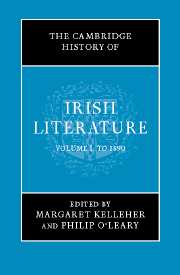Book contents
- Frontmatter
- Introduction
- 1 The literature of medieval Ireland to c. 800: St Patrick to the Vikings
- 2 The literature of medieval Ireland, 800–1200: from the Vikings to the Normans
- 3 The literature of later medieval Ireland, 1200–1600: from the Normans to the Tudors
- 4 Literature in English, 1550–1690: from the Elizabethan settlement to the Battle of the Boyne
- 5 Literature in Irish, c.1550–1690: from the Elizabethan settlement to the Battle of the Boyne
- 6 Prose in English, 1690–1800: from the Williamite wars to the Act of Union
- 7 Poetry in English, 1690–1800: from the Williamite wars to the Act of Union
- 8 Literature in Irish, 1690–1800: from the Williamite wars to the Act of Union
- 9 Theatre in Ireland, 1690–1800: from the Williamite wars to the Act of Union
- 10 Irish Romanticism, 1800–1830
- 11 Prose writing and drama in English, 1830–1890: from Catholic emancipation to the fall of Parnell
- 12 Poetry in English, 1830–1890: from Catholic emancipation to the fall of Parnell
- 13 Literature in Irish, 1800–1890: from the Act of Union to the Gaelic League
- 14 Historical writings, 1690–1890
- 15 Literature and the oral tradition
- Guide to major subject areas
- Index
- References
2 - The literature of medieval Ireland, 800–1200: from the Vikings to the Normans
Published online by Cambridge University Press: 28 March 2008
- Frontmatter
- Introduction
- 1 The literature of medieval Ireland to c. 800: St Patrick to the Vikings
- 2 The literature of medieval Ireland, 800–1200: from the Vikings to the Normans
- 3 The literature of later medieval Ireland, 1200–1600: from the Normans to the Tudors
- 4 Literature in English, 1550–1690: from the Elizabethan settlement to the Battle of the Boyne
- 5 Literature in Irish, c.1550–1690: from the Elizabethan settlement to the Battle of the Boyne
- 6 Prose in English, 1690–1800: from the Williamite wars to the Act of Union
- 7 Poetry in English, 1690–1800: from the Williamite wars to the Act of Union
- 8 Literature in Irish, 1690–1800: from the Williamite wars to the Act of Union
- 9 Theatre in Ireland, 1690–1800: from the Williamite wars to the Act of Union
- 10 Irish Romanticism, 1800–1830
- 11 Prose writing and drama in English, 1830–1890: from Catholic emancipation to the fall of Parnell
- 12 Poetry in English, 1830–1890: from Catholic emancipation to the fall of Parnell
- 13 Literature in Irish, 1800–1890: from the Act of Union to the Gaelic League
- 14 Historical writings, 1690–1890
- 15 Literature and the oral tradition
- Guide to major subject areas
- Index
- References
Summary
Introduction
The literary landscape of the period defined in linguistic terms as Classical Old Irish (c.800–900) and Middle Irish (c.900–1200) is remarkable both for its size and for the sheer variety of its terrain. Conventionally anchored historically by means of reference to the arrival of two groups of outsiders, Vikings and Normans, marking its beginning and its end, external influences form but one of its many fertile layers. The imaginative authors who continued to embrace European intellectual activity as their predecessors had done in the pre-Viking era were firmly grounded also in an insular inheritance which they continually made new. Earlier traditions may have been revered but their value lay primarily in their continued relevance in an ever-changing environment. Thus was the heritage of which such creators were keenly aware of being a part perennially translated into a current cultural context in which it continued to serve a role, being enlivened in the process by the host of other influences to which the tradition moulders were open. Analysis of their diverse literary output, therefore, must take into account, in John Carey’s formulation, their outward, as well as their backward look.
Similarly worthy of consideration is what might be termed their inward look, manifested most clearly in the vivid allusions to other works which permeate the literature. Working within a highly developed creative tradition, each weaver had access to the same well-worn fabric of his forebears and cut his cloth with pre-existing garments in mind. The result is a patchwork of repeating patterns in new imaginative guises which can only be properly assessed in an intertextual context.
- Type
- Chapter
- Information
- The Cambridge History of Irish Literature , pp. 32 - 73Publisher: Cambridge University PressPrint publication year: 2006
References
- 3
- Cited by

